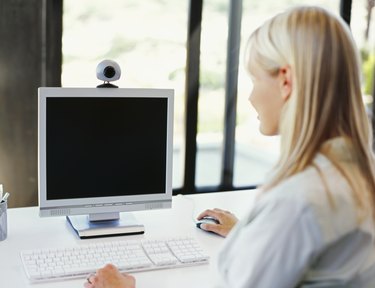
Your computer monitor should never be hot to the touch. Overheating can damage the computer's internal components and results from a variety of factors; a damaged VGA cable, poor ventilation and dirty vents can all lead to an overheating monitor. Because most of the reasons for an overheated monitor are external, it can typically be remedied by cleaning the monitor and ensuring it has proper air flow, helping it cool down to safer levels.
Step 1
Switch off both your monitor and computer while you clean to give both devices time to cool down. This is an excellent time to clean your computer as well, which helps improve air flow for a cooler temperature while operating and processing.
Video of the Day
Step 2
Locate the air vents on your monitor. The vents are typically found on either side of the monitor, but are also occasionally above the screen. The vents on your computer tower are different depending on your computer model, but most are small slits in the monitor casing.
Step 3
Angle the nozzle of a can of compressed air 10 to 15 inches over the tops of the vents. Don't blast air into the vents; this can push debris into the monitor and make your problem worse. Instead, blast dust and dirt along the side of the monitor to clean the surface of the casing and get rid of dust around the vents.
Step 4
Attach a nozzle attachment to your computer vacuum. Note that computer vacuums will not cause static buildup in your monitor -- regular vacuums can. Aim the nozzle directly over the vents to remove dust and debris.
Step 5
Wipe the outside casing of the monitor with a soft cloth, power up the computer and then assess the temperature while using your screen. If the monitor is still hot, try replacing the VGA cable, which is the cable that connects your monitor to your computer's video card. A malfunctioning cable could result in an overheated monitor, cable or port.
Step 6
Adjust your power options so your monitor switches off when it's not in use to save power and avoid future overheating. Click the "Windows" logo in the bottom left corner of your screen and then select "Control Panel." Click "Power Options" and then "Change Plan Settings." Select when you'd like the display to turn off after lack of use and then click "Save changes."
Video of the Day